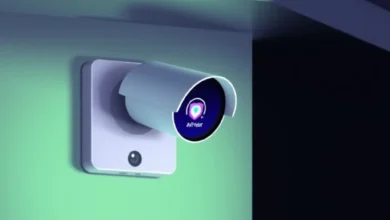Biometric Access Control: Ultimate Security Solution

As I stood in front of the sleek, modern entrance to my office building, I couldn’t help but feel a sense of unease. The days of fumbling with keys and ID cards seemed like a relic of the past. But in today’s world, where security threats loom large, I knew I needed a solution that could keep my workplace and its valuable assets truly protected.
That’s when I discovered the power of biometric access control – a cutting-edge technology that was about to revolutionize the way we think about security. With the simple touch of a finger or a glance at a camera, I could now access the building, confident that only authorized personnel could enter. Suddenly, the worries that had weighed on me seemed to melt away, replaced by a sense of relief and trust in the advanced security measures at my fingertips.

As I delved deeper into the world of biometric access control, I was amazed by the sheer breadth of its capabilities. Fingerprint recognition, facial scanning, iris identification – these were the tools that would safeguard not just my workplace, but countless others across industries, from healthcare to government facilities. The promise of enhanced security, increased convenience, and unparalleled accountability was a game-changer, one that I knew I had to explore further.
Key Takeaways
- Biometric access control revolutionizes security with cutting-edge technologies like fingerprint and facial recognition.
- It offers enhanced protection, increased convenience, and improved accountability compared to traditional access methods.
- Biometric access control is transforming security across various industries, from corporate offices to healthcare facilities.
- Understanding the benefits and potential challenges of this technology is crucial for implementing a successful biometric access control system.
- The future of biometric access control holds exciting advancements, with the potential to become an integral part of our everyday lives.
Understanding Biometric Access Control
Biometric access control is a cutting-edge security solution that utilizes unique human characteristics to grant or deny access to restricted areas or systems. This technology goes beyond traditional security measures by leveraging the power of iris scanning, vein pattern authentication, and other biometric identification methods.
What is Biometric Access Control?
Biometric access control is a security system that authenticates individuals based on their physical or behavioral traits, such as fingerprints, facial features, iris patterns, or voice recognition. These unique identifiers are captured, stored, and compared against a database to verify the user’s identity and grant or deny access accordingly.
How Biometric Technologies Work
Biometric access control systems work by collecting data from the user’s unique physical or behavioral characteristics. For example, iris scanning technology captures the intricate patterns of the iris, which are then converted into a digital template and compared against a database to confirm the individual’s identity. Vein pattern authentication, on the other hand, analyzes the unique vein structure in the user’s hand or finger to verify their access privileges.
These advanced biometric technologies provide a high level of security by ensuring that only authorized individuals can access sensitive areas or systems, significantly reducing the risk of unauthorized entry or data breaches.
| Biometric Technology | Description |
|---|---|
| Iris Scanning | Captures the unique patterns of the iris to verify identity |
| Vein Pattern Authentication | Analyzes the unique vein structure in the user’s hand or finger |
| Fingerprint Recognition | Identifies individuals based on the unique patterns of their fingerprints |
| Facial Recognition | Utilizes facial features to authenticate the user’s identity |
By understanding the core principles of biometric access control and the various technologies involved, organizations can make informed decisions about implementing these powerful security solutions to protect their assets and data.
Types of Biometric Technologies
In the realm of biometric access control, a variety of technologies have emerged to enhance security and convenience. From the traditional fingerprint recognition to the cutting-edge voice biometrics, each biometric modality offers unique capabilities and applications. Let’s explore these diverse biometric technologies in detail.
Fingerprint Recognition
Fingerprint recognition has long been a staple in biometric access control systems. This technology relies on the unique patterns and ridges found on an individual’s fingertips to verify their identity. Fingerprint scanners capture and match these distinctive features, providing a reliable and efficient means of authentication.
Facial Recognition
Facial recognition leverages the unique facial features of an individual to establish their identity. This technology utilizes advanced algorithms to capture and analyze the geometry of a person’s face, enabling seamless and contactless access control. Facial recognition is particularly useful in high-traffic areas where traditional methods may be cumbersome.
Iris Scanning
Iris scanning is a highly accurate biometric technology that identifies individuals based on the unique patterns within the colored ring of the eye. This method is renowned for its exceptionally low error rates, making it a preferred choice for sensitive environments that require the highest levels of security, such as government facilities and financial institutions.
Voice Recognition
Voice biometrics is an emerging technology that authenticates individuals based on the unique characteristics of their voice. This innovative approach to access control leverages the physiological and behavioral attributes of a person’s speech patterns, providing a convenient and contactless means of identification. Voice recognition is particularly useful in scenarios where hands-free operation is preferred, such as in healthcare or industrial settings.
While these traditional biometric modalities continue to dominate the market, newer technologies like palm vein recognition are also gaining traction. Palm vein recognition utilizes the unique vascular patterns within an individual’s palm to verify their identity, offering a highly secure and hygienic alternative to traditional biometric solutions.
| Biometric Technology | Key Features | Applications |
|---|---|---|
| Fingerprint Recognition | Unique fingerprint patterns, high accuracy | Access control, time and attendance, law enforcement |
| Facial Recognition | Contactless, automated identification, high scalability | Surveillance, security checkpoints, customer authentication |
| Iris Scanning | Extremely low error rates, highly secure | Government facilities, financial institutions, border control |
| Voice Recognition | Convenient, contactless, hands-free operation | Call centers, home automation, mobile device access |
| Palm Vein Recognition | Hygienic, highly accurate, difficult to spoof | Healthcare, banking, industrial access control |
These diverse biometric technologies offer a range of capabilities and applications, providing organizations with a comprehensive toolkit to enhance their biometric access control systems. By understanding the unique strengths of each modality, businesses can tailor their security solutions to meet their specific needs and ensure the highest levels of protection.
Benefits of Biometric Access Control
Biometric access control systems offer a range of compelling benefits that make them a game-changer in the world of security and access management. From enhanced security to increased convenience and detailed audit trails, these advanced technologies are revolutionizing the way organizations protect their valuable assets and maintain accountability.
Enhanced Security
Biometric access control leverages unique physiological characteristics, such as fingerprints, facial features, or iris patterns, to verify the identity of individuals seeking access. This approach is far more secure than traditional methods like key cards or passwords, which can be easily shared, lost, or compromised. Gait analysis and multimodal biometrics further strengthen security by incorporating multiple biometric factors, making it virtually impossible for unauthorized individuals to gain entry.
Increased Convenience
Biometric access control systems eliminate the need for users to carry or remember physical keys or access cards. Instead, individuals can simply present their biometric data, such as a fingerprint or a quick facial scan, to gain entry. This seamless user experience not only enhances convenience but also reduces the administrative burden associated with managing and distributing physical access credentials.
Audit Trails and Accountability
Biometric access control systems provide detailed audit trails, recording the date, time, and identity of individuals who have accessed a particular area or facility. This level of accountability is invaluable for security and compliance purposes, allowing organizations to quickly investigate any incidents and hold responsible parties accountable.
| Benefit | Description |
|---|---|
| Enhanced Security | Biometric access control systems leverage unique physiological characteristics, such as fingerprints, facial features, or iris patterns, to verify the identity of individuals seeking access, making it virtually impossible for unauthorized individuals to gain entry. |
| Increased Convenience | Biometric access control systems eliminate the need for users to carry or remember physical keys or access cards, providing a seamless user experience and reducing the administrative burden associated with managing physical access credentials. |
| Audit Trails and Accountability | Biometric access control systems provide detailed audit trails, recording the date, time, and identity of individuals who have accessed a particular area or facility, allowing organizations to quickly investigate any incidents and hold responsible parties accountable. |
By leveraging the power of gait analysis, multimodal biometrics, and other innovative biometric technologies, organizations can enhance their security, improve user convenience, and maintain robust audit trails for greater accountability. As biometric access control continues to evolve, these benefits will become increasingly crucial in safeguarding critical assets and ensuring the integrity of access management systems.
Applications of Biometric Access Control
The realm of biometric access control extends far beyond the realm of personal security. Fingerprint recognition, facial recognition, and other biometric technologies are proving invaluable across a diverse array of industries, revolutionizing how we approach security and accessibility.
Corporate Security
In the corporate world, biometric access control systems offer unparalleled protection for sensitive information and critical infrastructure. By verifying employee identities through fingerprints or facial scans, organizations can effectively restrict access to authorized personnel, minimizing the risk of data breaches and unauthorized entry. This heightened security measure not only safeguards valuable assets but also instills a greater sense of trust and accountability within the workplace.
Healthcare Facilities
The healthcare sector has embraced biometric access control as a means of enhancing patient privacy and safeguarding medical records. Biometric technologies, such as iris scanning and voice recognition, ensure that only authorized medical staff can access sensitive patient information, reducing the potential for data misuse or breaches. Moreover, these systems streamline the authentication process, enabling healthcare professionals to focus on providing high-quality care without the burden of cumbersome security protocols.
Government and Facilities Management
Governments and facility management teams have also recognized the transformative potential of biometric access control. Fingerprint recognition and facial scanning are being implemented to secure government buildings, military installations, and other critical infrastructure, ensuring that only authorized individuals can gain entry. This heightened level of security not only protects sensitive information and assets but also plays a crucial role in maintaining public safety and national security.
As the world becomes increasingly interconnected and the need for robust security measures intensifies, the applications of biometric access control continue to expand, redefining the landscape of access management across diverse industries and sectors.
Challenges in Biometric Access Control
As the adoption of biometric access control systems continues to grow, it’s essential to address the challenges that come with this innovative technology. From privacy concerns to cost implications and technological limitations, there are several factors to consider when implementing biometric security solutions.
Privacy Concerns
One of the primary concerns with biometric access control is the privacy of the data collected. Biometric data, such as iris scans and voice biometrics, are highly personal and can be used to identify individuals uniquely. Organizations must ensure that they have robust data protection measures in place to safeguard this sensitive information and comply with relevant privacy regulations.
Cost Implications
Implementing a biometric access control system can be a significant investment for organizations. The initial costs of hardware, software, and installation can be substantial, and ongoing maintenance and upgrades must be factored in as well. Smaller businesses or organizations with limited budgets may find the upfront costs prohibitive, making it challenging to adopt this technology.
Technology Limitations
While biometric access control technologies have made significant advancements, they are not without their limitations. Environmental factors, such as lighting conditions, can affect the accuracy of iris scanning and facial recognition systems. Additionally, voice biometrics can be influenced by background noise, accents, and changes in an individual’s voice over time. These technological limitations can impact the reliability and effectiveness of the security systems.
As organizations navigate the complexities of biometric access control, it’s crucial to address these challenges head-on and implement strategies to mitigate the risks. By balancing the benefits of enhanced security with the considerations of privacy, cost, and technological limitations, organizations can ensure that their biometric systems are effective, efficient, and compliant with relevant regulations.
Implementing Biometric Access Control
As organizations strive to enhance their security measures, implementing a robust biometric access control system has become an increasingly viable solution. This comprehensive process involves assessing your organization’s unique needs, selecting the right biometric technology, and seamlessly integrating it with your existing security infrastructure.
Assessing Your Organization’s Needs
The first step in implementing a biometric access control system is to conduct a thorough assessment of your organization’s security requirements. Consider factors such as the size of your facility, the number of employees, the sensitivity of the areas that require restricted access, and any specific security concerns you may have. This evaluation will help you determine the most suitable biometric modalities, such as vein pattern authentication or palm vein recognition, that can effectively address your organization’s unique needs.
Choosing the Right System
Once you have a clear understanding of your security requirements, the next step is to select the most appropriate biometric access control system. Research various biometric technologies, including fingerprint, facial recognition, iris scanning, and voice recognition, and evaluate their accuracy, reliability, and user-friendliness. Consider factors such as cost, maintenance requirements, and scalability to ensure the system aligns with your long-term goals and budget.
Integration with Existing Security Systems
Seamless integration with your current security infrastructure is crucial for the successful implementation of a biometric access control system. Work closely with your IT and security teams to ensure the new system can seamlessly communicate with existing access control, video surveillance, and other security components. This integration will provide a comprehensive and cohesive security solution, enhancing the overall effectiveness of your biometric access control measures.
By carefully assessing your organization’s needs, selecting the right biometric technology, and integrating it with your existing security systems, you can create a robust and reliable access control solution that safeguards your assets, protects your employees, and enhances the overall security of your organization.

Future Trends in Biometric Access Control
As the world continues to evolve, the landscape of biometric access control is also experiencing remarkable advancements. The future of this technology promises exciting possibilities that will revolutionize the way we secure our buildings, facilities, and everyday lives.
Advances in Technology
One of the most anticipated developments in biometric access control is the continued improvement of gait analysis. By analyzing an individual’s unique walking patterns, this technology can provide an additional layer of security, complementing traditional biometric methods like fingerprint or facial recognition. The integration of multimodal biometrics, where multiple biometric traits are combined for enhanced accuracy and reliability, is also gaining traction.
Cutting-edge sensor technology, coupled with advancements in artificial intelligence and machine learning, will enable biometric access control systems to become more accurate, responsive, and user-friendly. These innovations will pave the way for seamless and frictionless authentication, reducing the need for physical access cards or keys.
Adoption in Everyday Life
As biometric access control technology becomes more refined and cost-effective, we can expect to see its widespread adoption in various aspects of our daily lives. From smart homes that recognize our unique biometric signatures to public transportation systems that facilitate effortless entry and exit, the applications of this technology are boundless.
The convenience and security offered by biometric access control will make it an increasingly attractive option for businesses, governments, and individuals alike. As societal acceptance and trust in these systems grow, we may witness a future where biometric authentication becomes the norm rather than the exception.
“The future of biometric access control is one of unparalleled security, seamless user experience, and transformative convenience.”
As we look ahead, the advancements in gait analysis, multimodal biometrics, and the broader adoption of biometric access control technologies will shape the way we interact with the world around us, ushering in a new era of enhanced security and personal empowerment.
Legal and Ethical Considerations
As biometric technologies like fingerprint recognition and facial recognition become more prevalent in biometric access control systems, it’s crucial to address the legal and ethical implications. This section delves into the key considerations that organizations must navigate when implementing these powerful yet sensitive technologies.
Data Protection Regulations
The collection and use of biometric data are subject to strict data protection regulations, such as the General Data Protection Regulation (GDPR) in the European Union and the Health Insurance Portability and Accountability Act (HIPAA) in the United States. These laws mandate that organizations handle biometric information with the utmost care, ensuring the privacy and security of individuals’ sensitive personal data.
Ethical Use of Biometric Data
Beyond legal compliance, there are important ethical considerations surrounding the use of biometric data. Organizations must ensure that the deployment of fingerprint recognition, facial recognition, and other biometric technologies is transparent, fair, and non-discriminatory. Responsible data management practices, such as obtaining informed consent and providing clear explanations of how biometric data will be used, are essential to maintaining public trust.
“The ethical use of biometric data is not just a legal requirement, but a moral obligation. Organizations must prioritize the privacy and rights of individuals while leveraging the benefits of these powerful technologies.”
By addressing both the legal and ethical aspects of biometric access control, organizations can unlock the full potential of these technologies while upholding the trust and rights of their employees, customers, and stakeholders.

Comparing Biometric Access Control to Traditional Methods
As biometric access control systems continue to gain traction, it’s essential to evaluate how they compare to traditional security methods. Let’s dive into the key differences in terms of security levels, user experience, and cost-benefit analysis.
Security Levels of Biometric vs. Traditional
Biometric access control, such as iris scanning and voice biometrics, offers unparalleled security by relying on unique physiological characteristics that are nearly impossible to replicate. These technologies provide a far more robust layer of protection compared to traditional methods like keys, cards, or passcodes, which can be easily lost, stolen, or shared. Biometric systems ensure that only authorized individuals can gain access, significantly reducing the risk of unauthorized entry.
User Experience Differences
The user experience with biometric access control is often more streamlined and convenient than traditional systems. Instead of fumbling with keys or swiping cards, employees can simply look into an iris scanner or speak a passphrase to effortlessly gain access. This not only enhances productivity but also creates a more seamless and positive experience for end-users.
Cost-Benefit Analysis
While the initial investment in biometric access control systems may be higher than traditional methods, the long-term cost-benefit analysis often favors biometric solutions. Factors such as reduced security breaches, decreased replacement costs for lost or stolen credentials, and improved workforce efficiency can offset the upfront expenses. Additionally, as biometric technologies continue to evolve, the costs are expected to become more competitive with traditional access control systems.
FAQ
What is biometric access control?
Biometric access control is an advanced security system that uses unique physical or behavioral characteristics, such as fingerprints, facial features, or iris patterns, to verify a person’s identity and grant or deny access to a restricted area or resource.
How do biometric technologies work?
Biometric technologies work by capturing and analyzing an individual’s unique biological or behavioral data. For example, a fingerprint scanner captures the unique ridges and valleys of a person’s fingerprint, while facial recognition uses algorithms to map the unique features of a person’s face.
What are the main types of biometric technologies?
The most common types of biometric technologies include fingerprint recognition, facial recognition, iris scanning, voice recognition, and vein pattern authentication. Emerging technologies like palm vein recognition and gait analysis are also becoming more prevalent.
What are the benefits of biometric access control?
Biometric access control offers enhanced security, increased convenience, and improved accountability. By using unique physical or behavioral characteristics, biometric systems provide a more secure and tamper-proof method of access control, while also eliminating the need for traditional keys, cards, or passwords.
Where is biometric access control commonly used?
Biometric access control is widely used in various settings, such as corporate offices, healthcare facilities, government buildings, and facilities management. It helps organizations enhance security, streamline access management, and maintain detailed audit trails for accountability.
What are the challenges in implementing biometric access control?
Some of the key challenges in implementing biometric access control include privacy concerns around the storage and use of biometric data, the cost implications of deploying these systems, and the potential limitations of current technologies, such as issues with iris scanning or voice biometrics in certain environments.
How can I effectively implement biometric access control in my organization?
To effectively implement biometric access control, you should start by assessing your organization’s specific security needs and then choose the most suitable biometric technology. It’s also important to ensure seamless integration with your existing security systems and to address any legal or ethical considerations related to the use of biometric data.
What are the future trends in biometric access control?
Future trends in biometric access control include advancements in technology, such as improvements in gait analysis and the adoption of multimodal biometrics. Additionally, we may see a wider integration of biometric technologies in everyday life, from smart homes to public transportation systems.
How does biometric access control compare to traditional security methods?
Compared to traditional security methods like keys, cards, or passwords, biometric access control generally offers a higher level of security, as it is much more difficult to forge or duplicate a person’s unique physical or behavioral characteristics. Biometric systems also provide a more seamless user experience and can be more cost-effective in the long run, though the initial implementation costs may be higher.




